#1980s womenswear
Text
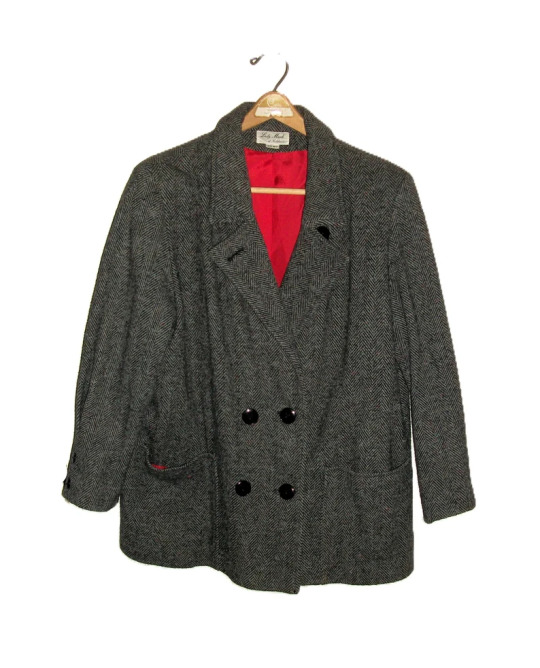
Vintage 1980s Gray Herringbone Double Breasted Dress Over Coat by Lady Mark of California Womens Size 20 WP Only $20
#vintage coat#womens vintage coat#size 20 vintage coat#vintage size 20 coat#1980s womenswear#plus size vintage#vintage plus size#genuine vintage#double breasted coat#vintage double breasted#plus size#etsy#susoriginals
0 notes
Text

Christian Lacroix AW1988 Haute Couture
#Christian Lacroix#AW1988#AW88#80s fashion#1980s#80s#fashion#runway#runway fashion#womenswear#runway looks#the fashion fold#womens fashion#womens style#80s aesthetic#eighties#couture#haute couture#high fashion
27 notes
·
View notes
Text



Purple Velvet Ballgown, 1989, English.
Designed by Victor Edelstein.
Worn by Diana, Princess of Wales.
Sotheby’s.
https://www.sothebys.com/en/buy/auction/2023/the-one/princess-diana-ball-dress-by-victor-edelstein
#sotheby’s#womenswear#purple#ballgown#dress#extant garments#1989#1980s#royal#known wearer#princess Diana#silk#velvet#20th century#1980s dress#1980s evening#1980s ballgown#Victor edelstein#1980s England#England#English#1980s Britain#British#Britain#1980s extant garment
21 notes
·
View notes
Text
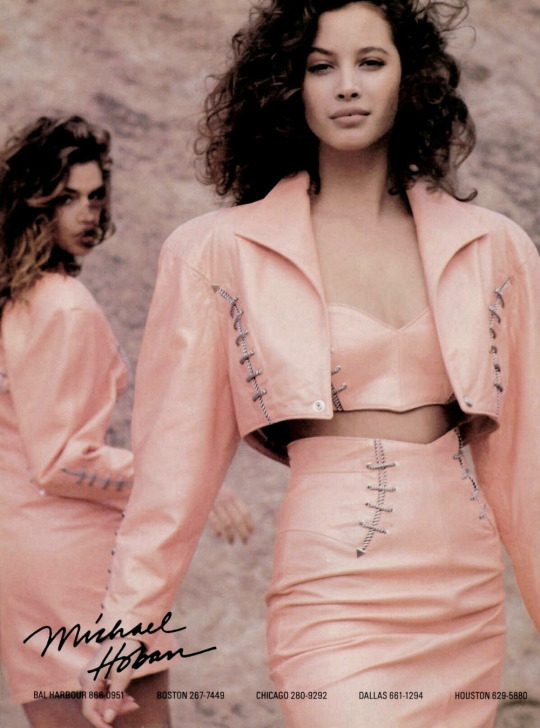
Christy Turlington & Cindy Crawford wearing Michael Hoban for North Beach Leather, 1988.
✴️ North Beach Leather
#mias playground#fashion#womenswear#1980s#michael hoban#north beach leather#christy turlington#cindy crawford#models in leather
10 notes
·
View notes
Photo

COMME DES GARÇONS® RUNWAY, 1980. PHOTOGRAPHY BY REI KAWAKUBO.
#astéticas#commedesgarçons#commedesgarcons#cdg#dress#dresses#pfw#1980#accessories#essentials#fashion#paris#collection#runway#runwayfashion#parisfashionweek#fashiondesign#design#womenswear#modern#reikawakubo#womensfashion#contemporary#designer#designs#hypebeast#highsnobiety#womensstyle#womenstyle#asteticas
11 notes
·
View notes
Text
THE 80S OUTFITS & STYLE
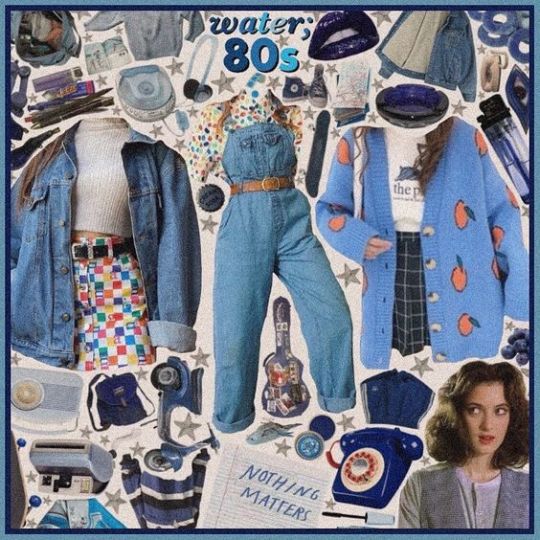
When thinking of 80’s fashion, the words ‘big and bright’ surely sum it up. It was a decade of big hair, shoulder pads, large and dramatic earring types, acid wash jeans, and eye-straining fabric colors and patterns. Fashion trends in the 1980s were about materialistic values and flaunting wealth. Having the right clothes meant spending the extra money to buy designer labels and sports goods with a brand logo.
#1980s#fashion#style#aesthetic#design#womenswear#80s fashion#80s design#vintage fashion#fashionblogger
1 note
·
View note
Note
hello! i am a longtime huge admirer of your clothing/fashion sense, as well as a longtime backreader of your #victorian and #goth tags. i am really interested in what you've written about Victorian dress, and i am looking to get more into 19th and 20th century clothing for gender + diy craft reasons. i'm so sorry if you've answered similar questions before, but do you have any tips for where a newbie should start researching? either way, thank you thank you, your blog opens my mind wide and brings me much joy and reflection!
General research:
Spend some time searching the 'net, museum websites, and archive sites for fashion plates (such as archive.org—link leads to a date-restricted query for "fashion"—or the Smithsonian—link leads to fashion plates in their image collection). Take note of what you like, as well as which styles correspond to which decade. Karolina Żebrowska has a good rundown of English fashion over the decades.
The undergarments are what does the most work creating the necessary silhouette to make Victorian & Edwardian womenswear fit properly. If you've figured out a decade you want your outfit to draw on, doing a quick search for "[decade] undergarments" should bring up plenty of blog posts, which may or may not cite primary sources (such is the fickle nature of the historical blogosphere). Bustle pads and sleeve supports can be purchased or made; they're both pretty simple, and tutorials abound.
Purchasing clothing:
Reproduction made-to-measure clothing can be readily found on etsy, but can be in the several-hundred USD range. I've had some luck finding vintage reproduction clothing (like, a skirt someone made by hand in the 1980s to a 1900s walking skirt pattern), which tends to be much cheaper.
Men, women, and children wore stays and corsets. As far as I know, Orchard Corset has the cheapest OTR corsets that are good quality and safe to wear. If you get a corset in the style of a specific decade handmade or made to measure, make sure that the seller tells you what the boning material is, what construction the boning is (spiral steel is sturdiest and most flexible), how many bones there are, what the corset material is, &c.—otherwise it's an indication of an unserious maker. Follow general advice for wearing corsets at a waist reduction (lace up slowly, break it in, &c.).
Antique Menswear on youtube gives a lot of good, practical advice for wearing late 19th-century and early 20th-century men's clothing (including where to buy reproductions and how to treat them, how to modify modern shirts to 19th-century standards with basically no sewing skills, &c.).
Actual antique clothing can be found and purchased online or at estate sales—usually in very small sizes, but I've seen Edwardian skirts and petticoats in an XL (also a small size, but...). You can also just simply browse this kind of thing for inspiration and save photos of anything you think you'd like to recreate.
Even clothing that was not "meant" to be worn by re-enactors can be clearly historically influenced (e.g. the huge boom in Victorian- and Edwardian- style blouses in the 1980s), so keep an open mind when shopping for vintage clothing! A lot of 1970s dresses that look "hippy" on their own can look very Victorian with the right undergarments and an updo. A lot of 1980s men's trousers also approach the right silhouette for the 1910s-inspired three-piece suit I'm trying to put together. Witness also the recent trend for big puffed sleeves!
Making or modifying clothing:
Victorian and Edwardian manuals for garment drafting and sewing can be found online—go to archive.org and search for "sewing," "drafting," or "dressmaking," then use the filters on the left to chuse which year(s) you want to see results from. Most of these have patterns that are sort of vibes-based: The work-woman's guide is one manual that claims to have patterns laid out strictly according to a grid.
I don't sew garments, but if Victorian pattern-writing for sewing is anything like it is for knitting, that may not be super useful. People do sell updates and graded 'translations' of antique patterns (which tend to be written in only one size) on etsy and ebay—just make sure from the description that it's 'deciphered' and translated rather than a scan of the original pattern!
One of the easiest things that you can do to add some Victorian or Goth flair to an otherwise plain-looking garment is to add trim. You can knit, crochet, or tat your own trim from Victorian lace-making patterns; purchase antique trim from resale sites; or buy braided or lace trim very cheaply at any craft store. Trim doesn't just have to go around the hems and cuffs of a garment: lace "insertions" between two pieces of fabric, as well as raised geometric patterns over the surface of a garment, are common in 19th-century clothing.

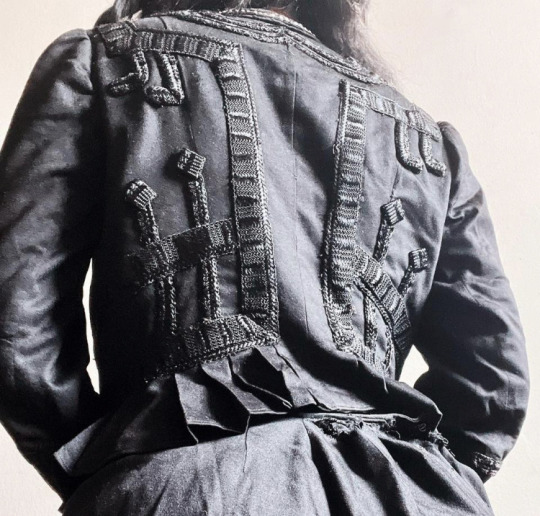
[ID: first image shows a black overdress showing lace insertions between strips of fabric of equal width, creating a striped effect. second image is the back of a black blouse with trim in a geometric design centred around right angles and parallel lines. end ID]
Jewellery (women's and men's):
Actual antique jewellery (including men's jewellery and fastenings) is not as expensive as you might think. Even if you're not willing to spend a lot of time learning what to look for and scouring estate sales for people who don't know or care what they have, late Victorian mass-manufactured costume jewellery often goes for sub-$50 or even $30 prices at auction on ebay (USD, in the US—in my experience it is even more plentiful and cheaper in the UK).
Specifically, I've lucked out with lots ("lot" as in, a bunch of small things being sold together) of "vintage men's accessories" going for $20 or so that contained Victorian cufflinks (in low-karat gold, mother-of-pearl, and jet), collar studs (in low-karat gold and base metals), and shirt studs (in low-karat gold, with garnets and seed pearls, &c.). Searching for lots of accessories is generally a good idea since by and large people do not know what these things are... but if you're willing to spend a little more for something that has been identified and is more likely to still be with its set, use the specific search term for that item (e.g. "antique collar studs").
Answers to Questions About Old Jewelry (though aimed at estate sellers and, if memory serves, full of regrettable pæans to Queen Victoria) is a good reference text to dating antique jewellery. I also recommend Miller's Illustrated Guide to Jewelry Appraising. Both of these texts are available on libgen.
Feel free to ask me follow-up questions if you want more detail on any of these points. As you can see I am perfectly happy to blather away on this topic
83 notes
·
View notes
Text










Claude Montana, "Dream Maker"
(29 June 1947 – 23 February 2024)
Claude Montana began his career in London with a jewelry line that was instantly noticed by the professional press. When he returned to Paris in the late 60s, he joined John Voigt's team at Mac Douglas, where he learned leatherwork, which he would later democratize through his own collections.
In 1975, he presented his first fashion show, to international acclaim. He launched his own House in 1979, assisted by his sister Jacqueline, and joined the Official Calendar of Paris Fashion Week Womenswear Fall-Winter 1981/1992, in April 1981. In 1989, he became artistic director of Lanvin, where he successfully experimented with Haute Couture.
During his time there, he was awarded two Dés d'or for the Autumn-Winter 1990-1991 and Spring-Summer 1991 collections.
After leaving Lanvin, he launches a new ready-to-wear line, Odyssée. Claude Montana was promoted to Commandeur dans l'Ordre des Arts et Lettres in July 2014.
Claude Montana leaves an indelible legacy in the fashion industry, his singular style still inspiring many contemporary designers.
With his unique vision and boundless approach he created his own vocabulary of fashion that continues to live on today; inspiring contemporary designers such as Alexander McQueen – who cited Montana in many of his collections – and most recently Montana’s influences can be seen in the sumptuous proportions of Tom Ford’s debut women’s wear collection.
As power dressing makes a return to the catwalk, it is Montana’s 1980s designs that create the basis for Stella McCartney’s autumn/winter 2011 voluminous silhouette, Balmain’s pointed and padded shoulders and Martin Margiela’s exaggerated angles.
Your work will forever be timeless and legendary.
Rest In Power !
#art#design#fashion#women's fashion#dressing room#luxury lifestyle#iconic#rip#rip claude montana#claude montana#stella mccartney#balmain#alexander mcqueen#tom ford#martin margiela#mac douglas#womenswear#lanvin#timeless
11 notes
·
View notes
Note
Hello Audrey! I would also be really interested in hearing your thoughts about video game fashion, I hope you don't mind! I'm a big fan of the game 古劍奇譚三 and while it's obviously a fantasy game, the NPCs' fashion stood out to me as clearly Ming dynasty-inspired. Would you like to give your thoughts on the accuracy? Here's a link to some of the designs I'm talking about: drive(.)google(.)com/drive/folders/1KuSmIPK91tbdvTbP4A5nlF6eS_E5LtWL?usp=sharing
Hi, yes judging by the images in the link it does look Ming Dynasty inspired! It’s not exactly historically accurate, as I would expect, but it’s clear that the designers put a lot of effort into research (or at least had a desire to do research), which is commendable. I was quite surprised to see the NPC designs because I’ve seen some pictures of the main characters and they look ahistorical af.

So a recurring inaccuracy is the sleeve length. Ming Dynasty robes had very long sleeves that were often longer than the wearer’s arms, even for the peasantry, and the sleeves in these designs are all too short. Since it’s a fantasy video game, I don’t see how having longer sleeves would be a hindrance to the characters, especially if they’re not playable fighting characters? Another overarching problem is the drawing of inspiration from a variety of time periods within the Ming, rather than a single decade/era. The lady to the top left wears a robe with a folded standing collar and a skirt with a wide bottom decorative strip, which are decidedly late Ming (early 17th century) features, but pairs them with a 半臂 banbi, which is early Ming (14th to 15th century). The various little accessories and embellishments also seem to be drawn less from history and more from 2010s commercial hanfu catalogues. The hairstyles are a bit more fantastical, the lady at top middle has some 2000s bangs going on. However, I do really like the overall silhouette of these designs apart from the short sleeves, especially the attention to the flat chests.

Early Ming portrait, showing similar silhouette and garments.

I have some more quibbles with this page. The two looks in the top row are not from the Ming, but the Qing. Top right is an especially widespread misinterpretation of the 水田衣 shuitianyi or “paddy field robe”, a garment (usually outerwear) made of patched geometric pieces of fabric, which was popularized in the late 17th century well into the Qing Dynasty. The small collar with petal shapes (which I learned recently was NOT considered a cloud collar) was also an 18th century favorite. The look was widely labelled in older books as Ming Dynasty, despite the artworks showing the style originating in the 17th and 18th centuries; they clashed with the stereotypical perception of Qing fashion and were thus mislabelled.

A widely circulated image of the shuitianyi (I’m not sure which particular book it’s from, something from the 1980s probably), which is obviously traced from early 18th century artworks.

Late Qianlong era export painting showing the robe and collar silhouette.
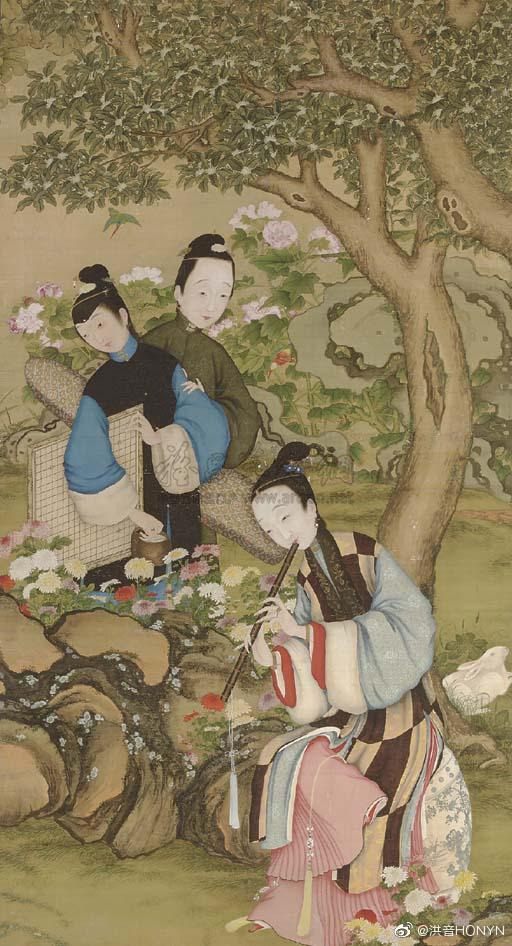
Early Qianlong era painting showing a lady in shuitianyi.
Returning to the character designs, the lady to the top left seems to be wearing something more akin to early Qing ceremonial dress or theater costumes than everyday Ming attire. The giant cloud collar plus the skirt with ribbons reads very much as theatrical, reminiscent of the 宫衣 gongyi. Her hairstyle also has not much historical basis, and is more likely taken from the guzhuang oeuvre.

Fantastical costume from an 18th century woodblock print.
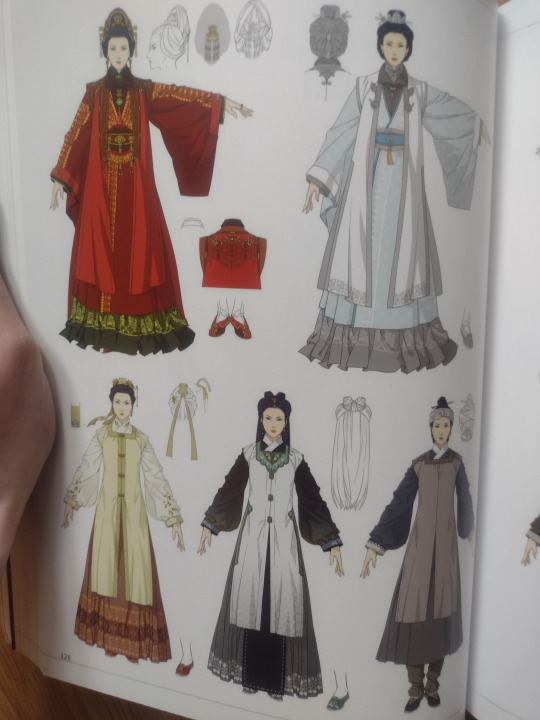
The two ladies at the top have a lot going on and they look kind of weird. The unclosed vest like garment looks to be a cursed combination of beizi and xiapei, and resembles neither. The interior garment is closed by a wide belt, which was not something that happened in womenswear during the Ming at all, and has its roots in guzhuang instead. Their outfits also mix cross collar garments with standing collar garments, which is anachronistic. They are wearing not one, but TWO garments with standing collars. People in the Ming were not SO fond of layering that they would turn down the collar on the outer robe just to reveal another one underneath... The hems of the skirts have an almost ruffled look; while many skirts in the Ming did not have pleats as sharp as the ones made by modern hanfu vendors, they’re still a far cry from this ruffled effect. The one thing I do appreciate is the decorative gold strip running down the sleeves of the red garment, that is something we do see in formal Ming dress. These two outfits are really overly exaggerated and pieced together from disparate elements found in various corners of the Ming’s existence.
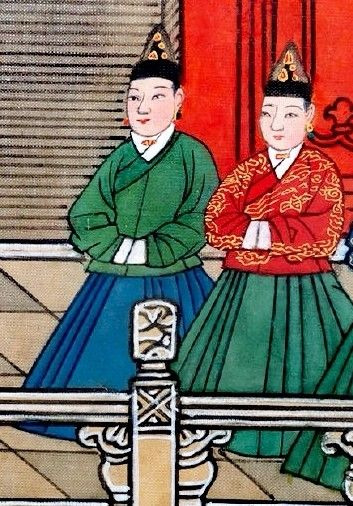
Snippet from 明宪宗元宵行乐图 showing gold decorative strip on sleeves, 1485.
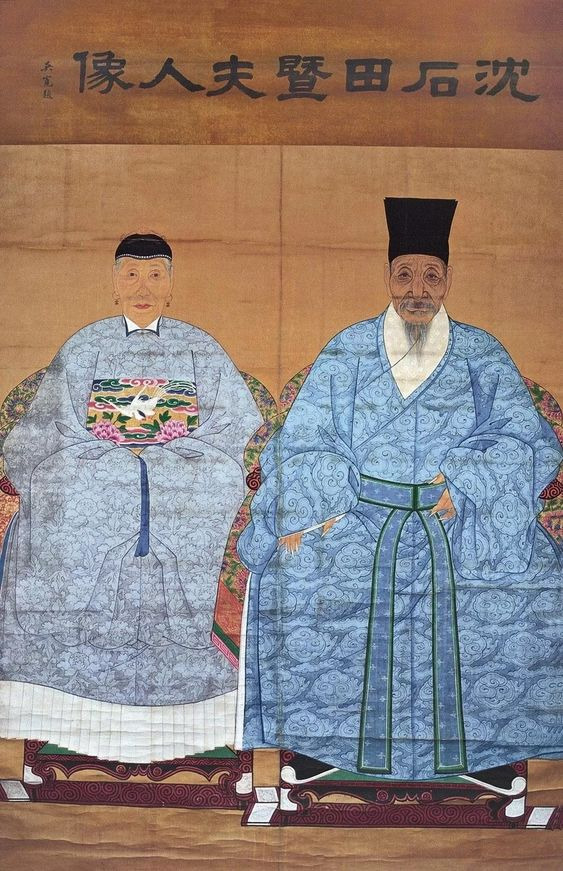
Late Ming portrait showing folded standing collar.
The girls in the bottom row are all wearing some version of the 比甲 bijia, which was associated with younger women and servants, so I think that’s a nice touch. Bijia usually had short or no sleeves, a square neckline and closes down the front with metal or cloth buttons.

I’m less knowledgeable about menswear so I won’t comment as much, but I think the problem of sleeve length carried over here as well. The general fit and silhouette is a bit too tight and not generous enough, considering how large and spacious Ming garments usually were. I do like that some male characters are wearing hats and headdresses, as historically most if not all men in the Ming covered their heads. The accuracy of the specific hats probably leaves much to be desired. The loose collar fit of the bottom row seems a bit odd, as Ming Dynasty robes with cross collars closed very tightly around the neck and wouldn’t allow so much of the inner layer to show. The guy at the top right is wearing a garment similar to the bijia (which was allegedly of menswear origin), commonly seen in military dress.

Ming style cross collar men’s robe.

Portrait of Emperor Xuande (?) in military dress, early 15th century.
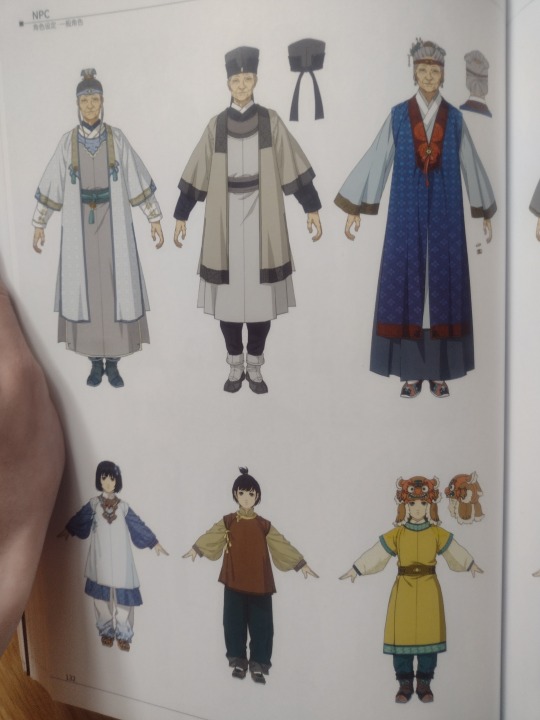
The outfits in the top row remind me more of childhood guzhuang dramas than anything from history to be honest, the wide belt and the wide trimming on the round collar robe are common features of guzhuang and very inaccurate. The headbands worn by the old ladies are reminiscent of 抹额 mo’e from the late 17th and early 18th centuries (again Qing Dynasty). The pairing of what seems to be a beizi with cross collar garments is anachronistic, again. I know nothing about children’s clothing so no comments.
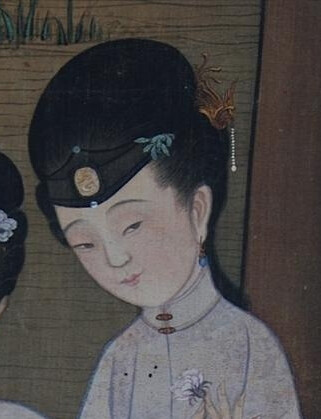
Snippet of a late 17th century (Kangxi era) painting showing mo’e.
Overall, I think the designers actually went and looked for information about Ming Dynasty dress and incorporated many elements of it into their designs, but in many places they fell flat because of either the dominance of guzhuang in costume design, over-reliance on older, antiquated literature or the inability (or unwillingness) to differentiate between different eras within the Ming, creating some very interesting fusions and some very cursed ones. The moments where their sources of inspiration skew toward the Qing are likely not intended, I think the creators were indeed trying to go for a Ming aesthetic but, because of the prevalence of 18th century erasure and appropriation in both academic and popular fashion history discussions, they simply didn’t recognize them as Qing. I do think it’s great that game designers are actively trying to depart from the guzhuang canon and create something new and interesting by incorporating actual historical dress, probably in no small part because they wanted to appeal to the popularity of hanfu among younger demographics. If they were more attentive to the details and silhouette I’m sure we’d see fabulous results.
#hanfu#ming dynasty#qing dynasty#18th century erasure#14th century#15th century#16th century#17th century#18th century#video games#costume analysis#古剑奇谭3
143 notes
·
View notes
Text
More info on Ryan’s outfit!
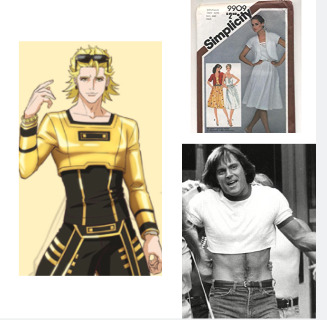
Today, tnbdirectory posted a translation (done by an anon) from the Katsura Exhibit event, and the topic was on character designs. We got a bit more information on Ryan’s S2 outfit:
Clothes: the inner layer is a long, seven-quarter length t-shirt covered by a gold bolero jacket made of a stretchy, metallic fabric
Now, here it says that Ryan is wearing a “bolero jacket,” which has some interesting history:
The open-fronted short jacket has its roots in the bullfighting rings of Spain. Before it entered the realm of womenswear, the bolero was designed for the toreadors of the early 19th century, who needed to wear something light, bright and easily discardable.
The long-sleeved collarless jacket eventually caught the eye of the female spectators, who deemed it a better match to their crinoline skirts than the long jacket style popular in the 1840s.
I love how this item of clothing started off as menswear, then women got inspired by it, and crafted similar garments on that. It’s a very fitting story of origin for our dear, Feminist(tm)Ryan, lol. Especially since, ever since that time, and into the 1980s, it was a style and article clothing very squarely in the womenswear category.
When I look at Ryan’s outfit, I feel like a crop top is more accurate. Especially since his “jacket” doesn’t have any buttons or zippers, and there is no opening at the front of the jacket, like there would be if this was a bolero jacket.
Let’s look at what the blog “A Brief Visual History of Men in Crop Tops” has to say about the topic:
According to the blog, Crop Tops Are For Guys, The crop top movement has been going strong since the 1970's. Originally, the cropped shirt was created "by men for men" in early 70's when weight lifters began cutting off the bottom of their shirts to gets around Gym dress codes that banned shirtless men.... sneaky, sneaky!
I feel like everything about the above really fits Ryan’s personality well. Crop tops for men became popular in the 1970s. A likely time period when Ryan was a teen, just like Ivan and Karina.It would be a good indicator that he was around their same age range.
Anyway, those are my final thoughts on Ryan and his clothing choices, haha.
I’m also going to update my master post on their outfits with this information.
Sources: The Natural News and A Brief Visual History of Men in Crop Tops
60 notes
·
View notes
Text
Fashion and the LGBTQ+ Community
Clothes and fashion have long been a part of our culture. Apart from providing shelter from climatic and natural circumstances, they also serve as a foundation for self-identity. Historically, there has been a clear distinction between the sexes when it comes to clothing. However, things have begun to change in the last fifty years. Because fashion is ever-changing, it was simple to adapt to LGBTQ (lesbian, gay, bisexual, transgender, queer, and others) trends to produce decisive statements and styles. In some ways, this is akin to the political or cultural influences on fashion.The LGBT community and its culture have had a significant impact on fashion. Several notable fashion designers from the previous century were homosexual. However, owing to cultural pressure, the majority of them stayed openly gay throughout their lives. Only in the 1980s did designers begin to include LGBT culture into their runway designs. Young designers like as Christopher John Rogers, Kelsey Randall, Patrick Church, Ludovic de Saint Sernin, and others are bringing a new wave of queer fashion to the modern world. These LGBTQ designers work hard to restore the visibility of the LGBTQ community in fashion, not just via their creations but also through powerful advertising campaigns.

LGBTQ community has shaped and influenced fashion over the years is discussed in the section below.
• Male Cross-Dressing: As discussed above, during the 18th century, secret and small homosexual subcultures formed in many cities in Europe. These cross-dressed men were called mollies in London, where they would gather around inns and public houses. They wore womenswear as a form of self-identification. Gowns, petticoats, fine laced shoes, scarves etc are a few of the examples of clothing items that they wore. Throughout the 19th century, homosexual men cross dressed both in private and public spaces. The Harlem drag balls of the 1920s and Arts Balls of 1950 offered safe spaces to cross-dress that were otherwise denied in everyday life. Drag queens were performers who used womenswear to showcase parody the straight society and create gay humour.
• Effeminacy: Not all gay men wanted to cross-dress. Societal oppression often denied such opportunities. These men would adopt feminine signifiers in terms of mannerisms and styles. Plucked eyebrows, eye makeup, high-heeled shoes etc are some examples. Cross-dressing was illegal in America unless one was attending a masquerade. The effeminate dress code gradually declined with the rise of LGBTQ liberation. However, it still plays an essential role in gay life.
• Masculinity and Lesbian Dress: The adoption of male clothing in women’s fashion started as a protest against the status and role of women in the patriarchal society. Cross-dressing allowed women for a very long time to pass and be accepted as men. However, the period between World War 1 and World War 2 saw a rise in the visibility of lesbians. They started including wing collars, monocles, and men’s jackets as a part of their dressing. Up until the 1970s, the image of lesbians in the public eye was based on a masculine idea. However, not all women wanted to be dressed like men. As a result, they started dressing up in the conventional female attire.
• Subtle Signifiers: The social oppression, as well as the legal limitations, forced the majority of the LGBTQ community to live their lives in secrecy even seventy years ago. Until the gay liberation movement in the 1960s, most gay men and lesbians would dress up so they could be considered heterosexual. However, secret symbols were developed and evolved over time. Certain colours and accessories were used as signals. The green colour was associated with effeminacy and had a gay association in clothing. Suede shoes and red ties were also signifiers during different time periods. Cufflinks, ties, the colour violet and short hairs were signifiers for lesbians.
referencing:
Blackman, Inge, and Kathryn Perry. "Skirting the Issue: Lesbian Fashion for the 1990s." Feminist Review 34 (Spring 1990): 67-78.
Cole, Shaun. Don We Now Our Gay Apparel: Gay Men's Dress in the Twentieth Century. Oxford: Berg, 2000.
Higgins, Ross. "A la Mode: Fashioning Gay Community in Montreal." In Consuming Fashion: Adorning the Transnational Body. Edited by Anne Bryden and Sandra Nieman Oxford: Berg, 1998.
Nestle, Joan. A Restricted Country: Essays and Short Stories. London: Sheba, 1988.
Wilson, Elizabeth. "Dyke Style or Lesbians Make an Appearance." In Stonewall 25: The Making of the Lesbian and Gay Community in Britain. Edited by Emma Healey and Angela Mason. London: Virago, 1994.
Sulagna Saha and Nand Kishore Baraik. (2022). Fashion and the LGBTQ+ Community. [Online]. fibre2fashion. Last Updated: September 2022. Available at: https://www.fibre2fashion.com/industry-article/9468/fashion-and-the-lgbtq-community#:~:text=Several% [Accessed 1 September 2023].
4 notes
·
View notes
Text


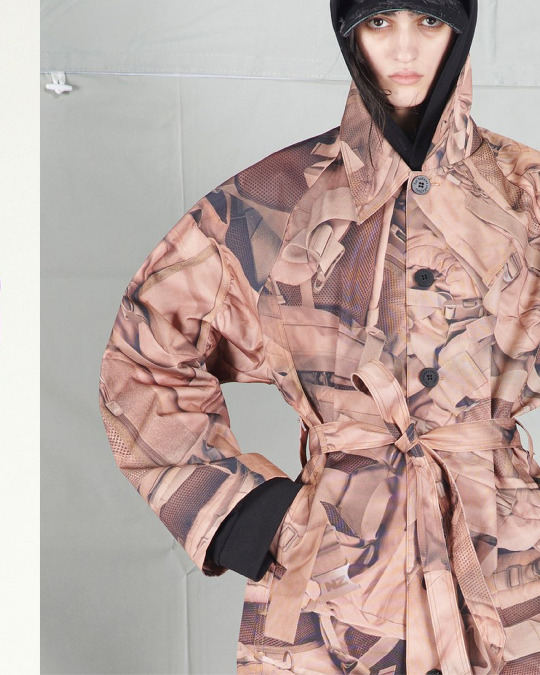
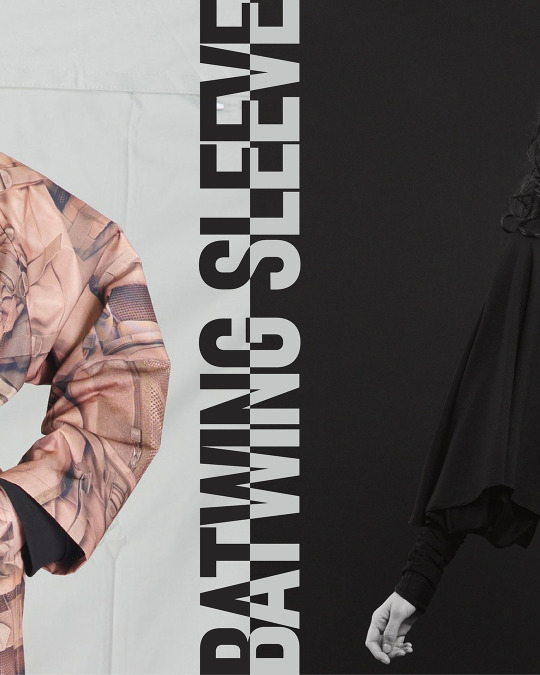





The Pre-Fall womenswear 2024 collections featured many different references, from prim 1950s tailoring at Dior to grungy 1990s check at R13.
There were also plenty of 1980s references:
Batwing sleeves at Isabel Marant, Ottolinger, and Salon 1884
Puff sleeves at Victoria Beckham, Huishan Zhang, and Reem Acra
Power shoulders at Balmain and Stella McCartney
Get the complete Pre-Fall 2024 trend report here.
#prefall 2024#prefall 24#fashion#the fashion fold#fashion blog#style blog#styleblog#womenswear#womens fashion#womens style#80s#1980s#80s style#80s aesthetic#Isabel Marant#Ottolinger#batwing sleeves#salon 1994#puff sleeves#Victoria Beckham#Huishan Zhang#reem acra#power shoulders#power dressing#balmain#stella mccartney
0 notes
Text

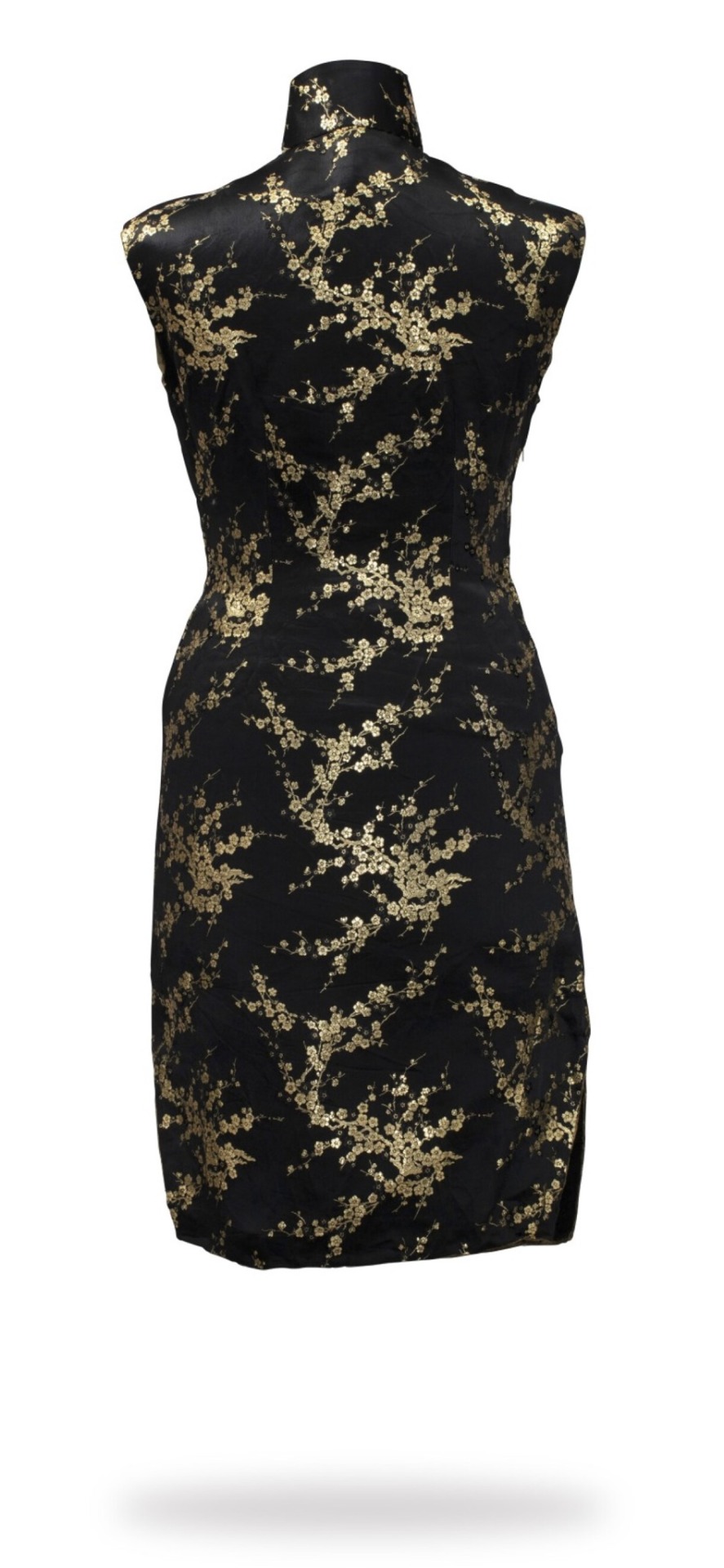
Black and Gold Satin Qipao Dress, 1986.
Sotheby’s.
https://www.sothebys.com/en/buy/auction/2019/collection-claudia-cardinale-dressing-a-star/unlabeled-circa-1968-black-satin-qipao-dress-sans
#sotheby’s#black#satin#gold#qipao#qipao dress#extant garments#womenswear#1960s#1968#1960s dress#20th century#dress#1980s extant garment
9 notes
·
View notes
Photo
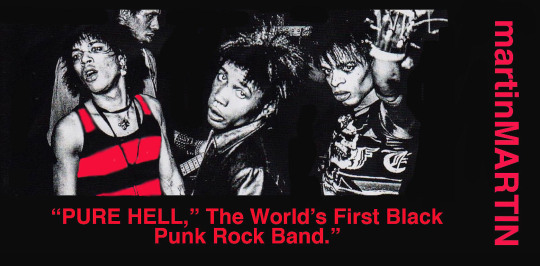
martinMARTIN:: Pure Hell was one of the first, if not the first, African American (Proto) Punk Rock bands. Pure Hell formed in Philadelphia in 1974. The band's first big break came when they toured Europe with the Sex Pistols. They spent time playing in New York city, eventually becoming friendly with and performing with The New York Dolls. They also played with Sid Vicious of The Sex Pistols in 1978 when he moved to New York City. Interesting to note:: Pure Hell's drummer, Michael "Spider" Sanders was our design assistant at my first fashion label, valluccio, with my then partner, Janice Braveman. Spider worked for valluccio for one year in and around 1980 here in Los Angeles, California. "Spider is pictured on the left wearing the red and black stripe t-shirt:: Graphic Design / Lay-Out by +junYOSHIDA:: Photography courtesy of Pure Hell::
martinMARTIN Website:: https://martinmartin.net
martinMARTIN Instagram:: https://instagram.com/martinmartin_official
martinMARTIN Twitter:: https://twitter.com/martinMARTIN_
martiinMARTIN STORE Twitter:: https://twitter.com/martinMARTIN_S
#martinmartin_official #dianemossmartin #purehell #deconstructedfashion #fashionphotography #photooftheday #avantgardefashion #antifashion #drapedfashion #darkfashion #black #workinginthreeshadesofblack #transcendinggenderfashion #adultpunk #punkluxuryfashion #minimalism #beautiul #inspiration #collection #clothes #womenswear #menswear #instafashion #pfw #parisfashionweek
2 notes
·
View notes
Photo
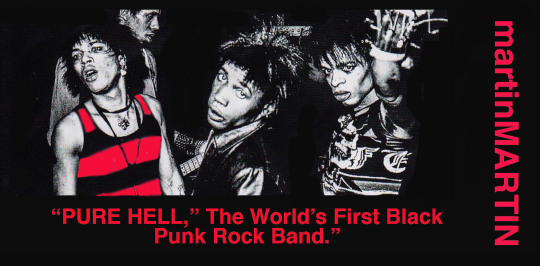
martinMARTIN:: Pure Hell was one of the first, if not the first, African American (Proto) Punk Rock bands. Pure Hell formed in Philadelphia in 1974. The band's first big break came when they toured Europe with the Sex Pistols. They spent time playing in New York city, eventually becoming friendly with and performing with The New York Dolls. They also played with Sid Vicious of The Sex Pistols in 1978 when he moved to New York City. Interesting to note:: Pure Hell's drummer, Michael "Spider" Sanders was our design assistant at my first fashion label, valluccio, with my then partner, Janice Braveman. Spider worked for valluccio for one year in and around 1980 here in Los Angeles, California. "Spider is pictured on the left wearing the red and black stripe t-shirt:: Graphic Design / Lay-Out by +junYOSHIDA:: Photography courtesy of Pure Hell::
martinMARTIN Website:: https://martinmartin.net
martinMARTIN Instagram:: https://instagram.com/martinmartin_official
martinMARTIN Twitter:: https://twitter.com/martinMARTIN_
martiinMARTIN STORE Twitter:: https://twitter.com/martinMARTIN_S
#martinmartin_official #dianemossmartin #purehell #deconstructedfashion #fashionphotography #photooftheday #avantgardefashion #antifashion #drapedfashion #darkfashion #black #workinginthreeshadesofblack #transcendinggenderfashion #adultpunk #punkluxuryfashion #minimalism #beautiul #inspiration #collection #clothes #womenswear #menswear #instafashion #pfw #parisfashionweek
2 notes
·
View notes
Text
How Giorgio Armani Revolutionized Modern Fashion Trends
With a visionary eye and unparalleled creativity, Giorgio Armani has undoubtedly left an indelible mark on the world of fashion. From his humble beginnings in the Italian fashion industry to becoming a global icon, Armani has revolutionized modern fashion trends, seamlessly blending sophistication with contemporary style.

The Birth of the Armani Brand
Giorgio Armani's journey in the fashion world began in the early 1970s when he, along with his friend Sergio Galeotti, founded the Armani brand. The duo had a shared vision of creating garments that were not only fashionable but also reflected the changing times. Armani's early designs were characterized by clean lines, minimalist aesthetics, and a focus on high-quality fabrics.
Armani's breakthrough came in 1975 when he introduced his first menswear collection. The collection featured sharply tailored suits that were a departure from the flamboyant styles of the time. Armani's suits were sleek, modern, and exuded an air of confidence. This collection not only garnered critical acclaim but also caught the attention of influential figures in the fashion industry, propelling Armani into the limelight.
Giorgio Armani's Impact on Fashion Trends
Armani's impact on fashion trends cannot be overstated. He revolutionized the concept of power dressing, redefining how men and women dressed in professional settings. His designs celebrated individuality while adhering to a timeless elegance that resonated with people from all walks of life.
One of Armani's most significant contributions to fashion was his ability to bridge the gap between high fashion and everyday wear. He believed that fashion should be accessible and wearable, without compromising on style and quality. Armani introduced the concept of "luxury casual," creating a new category of clothing that combined comfort with sophistication. This approach paved the way for a more relaxed and effortless style that continues to influence fashion trends to this day.
Armani's Signature Style and Design Philosophy
Armani's signature style can be described as understated yet impactful. He has a keen eye for detail and a meticulous approach to design. Armani's designs are known for their impeccable tailoring, clean lines, and use of luxurious fabrics. He believes that clothes should enhance the wearer's natural beauty and not overpower their personality.
Armani's design philosophy is rooted in simplicity and timelessness. He believes that fashion should transcend trends and create pieces that can be worn for years to come. Armani's designs exude an air of sophistication and elegance that transcends seasons, making them a staple in many wardrobes.
Armani's Iconic Red Carpet Moments
Armani's creations have graced the red carpets of Hollywood for decades, adorning some of the biggest stars in the entertainment industry. His designs have become synonymous with glamour and have set the standard for red carpet fashion.
One of Armani's most memorable red carpet moments was when he dressed Richard Gere for the 1980 Academy Awards. Gere wore a navy blue Armani tuxedo, which became an instant sensation and solidified Armani's position as a go-to designer for Hollywood's elite. Since then, Armani has dressed countless celebrities for prestigious events, including the Oscars, Golden Globes, and Cannes Film Festival.
Armani's Contributions to Menswear Fashion
While Armani is celebrated for his contributions to womenswear, his impact on menswear fashion is equally significant. Armani's menswear collections challenged traditional notions of masculinity and introduced a new era of sophistication and style.
Armani's suits became a symbol of power and success, and his designs revolutionized the way men dressed in professional settings. He introduced softer silhouettes, slimmer cuts, and a more relaxed approach to tailoring. Armani's menswear collections blurred the lines between formal and casual wear, creating a new standard in menswear fashion.
Conclusion
As we celebrate the remarkable journey of Giorgio Armani, it is clear that his legacy will continue to inspire and shape the way we dress for years to come. From the runways of Milan to the red carpets of Hollywood, Armani's creations will forever be a testament to his unparalleled creativity and unwavering commitment to revolutionizing modern fashion trends.
0 notes